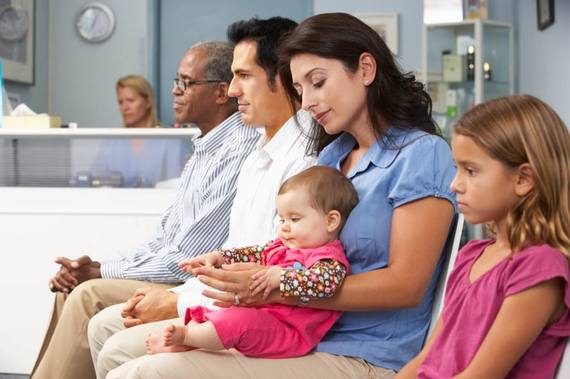It's been three years since my daughter's initial cancer diagnosis. Since then, we've visited the pediatric oncology clinic for treatment, follow-up scans and meetings with her doctor. These days she is seen on a not quite monthly basis, depending on her latest scan results. It amounts to a lot of time in the waiting room.
This past Friday she had another scan. When it was done we dutifully reported to Pediatric Oncology to get the results and speak with her doctor. It was a busy day in the clinic which required a particularly long wait, but I had plenty of time to reflect on what the clinic waiting room has taught me since entering the world of pediatric cancer.
It's not all doom and gloom. It's easy to assume that a pediatric oncology clinic -- the place where kids get pumped full of chemotherapy, poked with needles and are confined indoors for hours on gorgeous autumn days -- is a place of misery filled with the sad cries of children and the despondent stares of parents. But, I'm here to tell you it's not like that at all. Well, mostly. Sure kids cry and parents look exhausted and worried, but three pediatric clinics I've visited were all filled with toys, painted cheery colors, and had more happy kids than crying ones. I credit the lack of tears to the highly skilled and compassionate staff (they know how to find a vein quickly), modern technology such as ports that require less needle sticks thus less pain, and a superhuman effort by all involved with the department to keep the space bright, comfortable and hopeful.
Childhood can thrive anywhere. If you don't see their bald heads, or notice that the IVs they're pushing around are attached to lines that hook directly into their chests, then you might not know you're in a waiting room filled with kids who have cancer. They run, play, draw and fight (with each other) just like they're supposed to. There are often people (volunteers or staff, I'm never sure) who have brought in craft projects and art supplies for the patients and their siblings. There are always young artists hard at work on a new masterpiece -- filled with smiles and covered with paint. There is always one big brother or sister who is pulling a smaller (giggling) sibling around in a plastic wagon. Always.
Children are amazingly strong. From the 4-year-old boy who bounds into the clinic straight from the elevator, his dimples showing just above the face mask he's wearing to protect him from germs, to the lanky teenager with the not-so-pronounced limp who checks himself in (with an eye roll and a snicker), I am astounded at the resilience of these kids. The tiniest ones are only months old. The oldest ones are a foot taller than me. Yet no matter their age or size or background, they keep coming, keep getting their treatment, keep believing in their parents and their doctors with sincerity and hope. Most of them will spend the entire day here, but they don't complain. They are little warriors fighting for a chance to grow up. I'm honored to share the same space with each and every one of them.
Parents are amazingly strong. Remember that tiny little baby I mentioned above? She's being held by an exhausted-looking mother or father who is pushing her I.V. pole with one hand while juggling baby, bottle and diaper bag in the other. There's a father who's been holding his preschooler for four hours and a mother sitting near the window balancing her squirming toddler on her lap so she can look outside. There is a couple hovering around their (annoyed) teenage daughter making sure she gets a comfortable seat and a snack after a long day of getting scanned (oh wait, that's us...) So, yes, I am reminded how strong parents must be in the pediatric oncology waiting room, but I am also reminded that we are all still parents, doing typical parental things in a very atypical environment.
Every single staff member is critically important. There's a woman who checks my child in and makes sure she has her i.d. bracelet on. There's a man who weighs my daughter and takes her blood pressure. There's the oncologist who is delayed because there were three new patients admitted that day. There's the nurse who draws her blood as painlessly as possible and acknowledges that, yes, it hurts and she's so very sorry. They don't have to be there. They have chosen to work in this place of sick children and soul sick parents. They come in each morning and make sure the machinery keeps working as it should and that the environment is a haven of healing -- a place where childhood can thrive even under the darkest of clouds. I can't thank them enough for doing the job they do.
And, finally... there is much more going on than is readily apparent. It may look like a normal pediatrician's office, but it's not. There are conversations occurring behind the scenes that are heartbreaking -- discussions about end of life care, invasive and disfiguring surgeries, and the painful induction of the newly diagnosed. There is the constant struggle of remaining hopeful beneath the ever-present weight of despair. There are the children who are too sick to paint or play, sitting pale and quiet while they wait for their treatment to be over so they can go home. There is profound exhaustion--from parents, children, physicians and supporting staff members who must face this heartache each and every day and stay strong. Like most things in life, there is good and there is bad. That's what the pediatric oncology waiting room has taught me.
